
Considering I build websites for responsible tourism companies, I only recently realised that I wasn’t thinking enough about the internet from an accessibility point of view. Nor, it would seem, are many of the responsible tourism companies I have worked with.
Recently, however, I read the accessibility page on the website of Native Hotels. Aside from being in six languages, www.nativehotels.org goes much further than most to ensure its website can be read easily by as many people as possible.
As Native Hotels explains: “With the W3C system (the most used in the world) you can use a Braille Line which converts to dots the text that appears on the screen. And you can use the hearing system Jaws that reads the text on the screen as fast as you want. Among other solutions. And with InSuit tool you can access the information without viewing the screen, without touching the keyboard and without talking to the computer. We can simply blow on the microphone of our headphones. This system allows navigation even to a blind, mute and hands motionless user. And you can use it on any computer, not necessarily yours, because accessibility is embedded in the website and do not need peripherals or specific programs.”
To see how far the majority of tourism websites fall below this, it’s worth checking how well your own website measures up using various website accessibility checkers, or alongside something like Berkeley University’s Top 10 Tips for Making Your Website Accessible or this guide to making your wesite disability friendly from Mashable. The articles both cover topics such as use of colour, how to implement heading tags such as H1 and H3, and the correct labelling of images, since those ‘alt-tags’ aren’t just another SEO-grabbing device. They are there to enable screen reader users to understand the message conveyed by the use of images on the page.
However, a lot of SEO and Accessibility guidelines do overlap. Which means that if your website is built and structured correctly then it will be easy for both search engines and all your potential human clients to read.
This is an excerpt from an article first published by World Travel Market. Read the original article here: #TOURISMFORALL – Is your travel website reaching as many guests as possible? | Travel Industry Blog, Reports, Press Releases | WTM London


